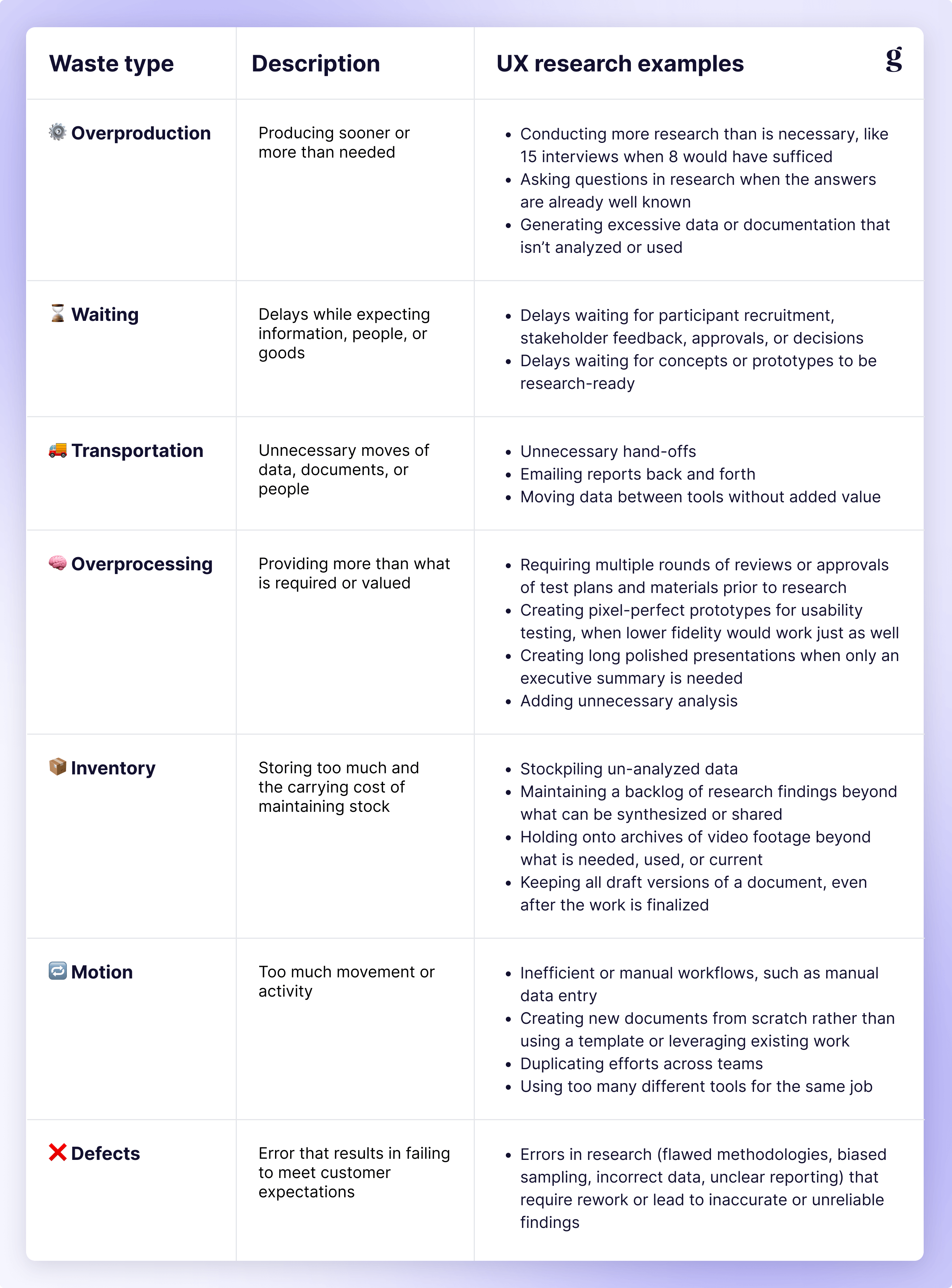
Here's the reality: Not every task we do at work adds value. In fact, much of it is just waste.
I first faced this uncomfortable truth while learning about Lean Thinking more than a decade ago. Long before joining the B2B software industry, I started my career working for Whirlpool Corporation, a global appliance manufacturer. After several years of doing UX design and user research on products like washing machines, I pivoted my career and spent five years in the company’s Quality organization. It was in that role where I took an intensive training course on Lean, which was possibly the most transformational (and humbling!) experience I have ever had in my career. Lean Thinking helped me see what I was doing that didn’t add value and what I could do about it. It literally changed how I view work and work processes, including those in UX research.
To clarify, the term "Lean" or "Lean Thinking," as used here, does not refer to reducing staff numbers, adhering to "do more with less" philosophies, or even implementing the practices of books such as The Lean Startup or Lean UX.
Rather, Lean Thinking is a mindset and systematic approach that, among other things, seeks to minimize waste and maximize customer value. Originating from Japanese manufacturing — specifically Toyota starting in the 1950s — Lean Thinking has since spread far beyond manufacturing and is applicable to processes everywhere. At its core, it is all about transforming how you see and think about your work.
“Lean thinking is more than just employing specific tools or tweaking a few steps in a business process – it’s all about changing how you see your business and how you recognize business operations. It's a worldview that’s adopted to change the way you think about your business.” - Simplilearn, Lean Thinking: Overview, Principles, Benefits & Applications Explained
While there are five main pillars of Lean1, one often gets the most attention: Maximize the value-to-waste ratio. This means recognizing what is valuable and what is not and eliminating those actions and behaviors that ultimately don’t add value.
———
1 The 5 pillars include: 1) directly observing work, 2) maximizing value-to-waste ratios through systematic waste elimination across the entire system, 3) reaching alignment on both “what” should be done in a process as well as “how”, 4) permanently solving problems, and 5) creating a learning organization capable of continuous improvement (Kaizen).
At the heart of Lean is a deceptively simple but powerful question: What is valuable?
From a Lean perspective, value is always assessed from the perspective of “the customer.” And, while the end user or purchaser of your product or service is certainly a customer, the Lean definition of customer extends to anyone – internal or external – who is the recipient of the output of a process step. This output not only includes products and services, but also information, insights, and decisions. By this definition, the product managers, designers, engineers, and business stakeholders who use research to make decisions are obvious customers of your work. Your manager and other leaders in your organization are also key customers, as are your research peers. And, in many cases, you – or rather, your future self – are also your own customer!
From the perspective of the customer, value is anything that:
In other words, value is the output or result that truly matters to your customers.
Waste, on the other hand, is anything beyond the minimum resources needed to add value for the customer. So, if something doesn’t add value and is not absolutely necessary to create a valuable output, it is waste2.
Tip: Waste often occurs when either the customer(s) or what they value are not known or are ill-defined. That's why it's vital to articulate the direct and indirect customers throughout your UX research processes and discover what ultimately constitutes "value" to each of them. Understanding what value looks like from their perspectives can help you identify which upstream behaviors lead to valuable outputs and which ultimately do not.
———
2 As I noted earlier, my training in Lean Thinking was transformational for me, but also incredibly humbling. I was in the Quality organization at the time, a function that generally exists because things aren’t always designed right, made right, or handled right the first time. When I learned the Lean definitions of value and waste, it occurred to me that my entire department was waste. Much of my role, in fact, did not actually provide value to our end customers. And as someone who thrives on helping others and feeling valuable, this was a very sobering thought!
So, I took it upon myself to reduce as much waste as I could in my own processes, processes in my department, and even in our production processes. I led Kaizen, or continuous improvement, activities in manufacturing sites and distribution centers and helped to standardize processes for how quality activities were done across sites. And, ultimately, I chose to pivot my career back to areas where I felt that I was transforming the product and adding value from the beginning. Which brought me to Innovation and later back to UX research where I had begun my career.
Lean Thinking identifies seven types of waste3 that undermine efficiency and value. Here’s each of these wastes as well as examples of how they might manifest in UX research:

Some say that there is an eighth waste as well, which is unused talent – what you miss out on because people’s time and energies are wasted in these other ways.
———
3 In Japanese, the wastes are called muda, a word meaning "futility", "uselessness", or "wastefulness.”
Here are actionable strategies to help you and your team find and reduce waste, and ultimately amplify value:
Utilize contextual inquiry tools to observe UX research processes in action, and then diagram them from end to end using a value-stream map (VSM). This helps identify each step, the time it takes, and the resources involved. By mapping the process, you can pinpoint areas where value is added and where waste occurs.
Every process is a sequence of distinct activities and every activity, even creative ones, can be structured to some degree. To structure an activity, specify the outcome, sequence, timing and method.
When interacting with stakeholders, outline the procedures for submitting requests and sharing information. For example, specify how email or messages should be used for team communications, if a particular form or document is required to structure information, whether messages should be directed to a specific person, or if documents need to be uploaded to designated locations. Lack of consistency in these processes can result in confusion, increased difficulty locating information, and delays in response times.
Don't make things more complex than necessary. Choose quick, straightforward approaches unless the circumstances demand a more thorough technique.
Good scoping, clear methodology, and pilot tests reduce the risk of defects and costly rework later.
Create templates for recruiting, discussion guides, and reporting to avoid reinventing the wheel each time.
Use tools, like Great Question, that consolidate participant management, data analysis, and reporting. Minimize tool-switching and manual work.
Don’t let data and findings languish in docs or spreadsheets. Make synthesis a team ritual to continuously surface insights and act on what matters most.
For each project, define the “minimum viable report” that delivers value to stakeholders. Instead of long reports, consider short readouts, workshops, or live debriefs.
Set up feedback loops with stakeholders to assess the value of research outputs and find areas for improvement.
Applying Lean Thinking to UX Research isn’t necessarily about doing more with less — it’s about doing more of what matters and less of what doesn’t. By identifying your customers, defining and prioritizing what is valuable to them, recognizing the seven wastes, and building smart strategies to eliminate them, you’ll help your research organization thrive.
Sara currently lives in the greater Boston area in a multi-generational home with her husband, son, father, and retired racing greyhound, Moxie. Before joining ServiceNow in 2022 as a Sr. Staff UX Researcher, Sara was at Bose where she focused on surfacing insights to fuel front-end innovations. Prior to Bose, Sara spent 14 years at Whirlpool Corporation in Southwest Michigan in a variety of roles in Global Innovation, Design Research, User Experience, and Quality. Sara is an avid collector of wine and rubber ducks and enjoys traveling the world, especially by cruise ship. She enjoys all forms of mental challenges (like escape rooms, board games, Wordle, etc.) and is especially competitive when it comes to pub trivia.